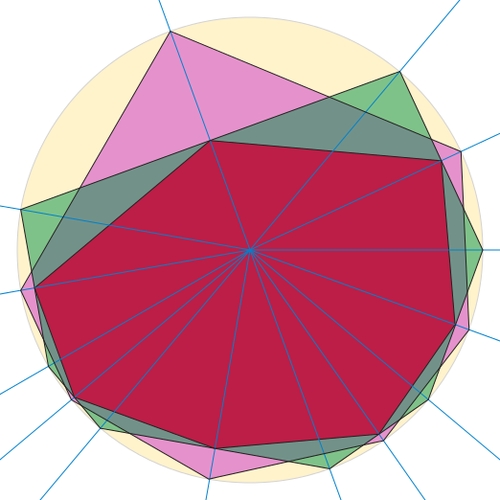Good -gons
 Consider a convex
-gon
. An
-gon with all its vertices among those of
is called good if it doesn't share any edge in common with
. Let the number of such
-gons be
.
Consider a convex
-gon
. An
-gon with all its vertices among those of
is called good if it doesn't share any edge in common with
. Let the number of such
-gons be
.
Find the digit sum of .
Note 1 : All numbers are expressed in base . You may need a CAS to find the digit sum.
Note 2 : Try this easier variant first.
Looking forward to see different solutions :)
Image credit: Wikipedia David Eppstein
The answer is 194.
This section requires Javascript.
You are seeing this because something didn't load right. We suggest you, (a) try
refreshing the page, (b) enabling javascript if it is disabled on your browser and,
finally, (c)
loading the
non-javascript version of this page
. We're sorry about the hassle.
Not only will we find out what N 2 0 + N 1 5 is, but we will also find out what N x is for any positive integer x , where x ≥ 3 . Let's think about how we will construct such a polygon. First, we have 2 0 1 5 points to start out the first vertex of the polygon. Next, we have x − 1 vertices left to pick. But there is a clever 1-1 correspondence between this problem and stars and bars/sticks and stones. We have a total of 2 0 1 5 vertices in a 2 0 1 5 -gon. In order to have a good x -gon in which no two vertices are consecutively used from the 2 0 1 5 -gon, we can simplify this down into a 1 + a 2 + . . . + a x = 2 0 1 5 where all the addends are greater than or equal to 2. a 1 , a 2 , . . . a x all represent the number of vertices from the 2 0 1 5 -gon that are between each side of the x -gon. Now, we can simplify down our equation into a 1 + a 2 + . . . + a x = 2 0 1 5 − x where a 1 , a 2 , . . . , a n are all positive integers. Using stars and bars/sticks and stones, we have 2 0 1 5 − x − 1 = 2 0 1 4 − x stars/stones and x − 1 bars/sticks. Therefore, we have ( x − 1 2 0 1 4 − x ) such good x -gons. But all good x -gons are overcounted. Consider such a good x -gon. We had 2 0 1 5 points to start the first vertex off at. So therefore, we could have started our good x -gon off at any of the vertices of our x -gon. We need to divide our final answer by x to account for the rotations. So our final answer is x ( x − 1 2 0 1 4 − x ) . Plugging in for x = 2 0 and x = 1 5 , we have 1 5 2 0 1 5 ∗ ( 1 4 1 9 9 9 ) + 2 0 2 0 1 5 ∗ ( 1 9 1 9 9 4 ) . In Note 1 as stated in the problem, you need a CAS to find the digit sum of this, but I do not know what CAS stands for and instead went to Wolfram Alpha to find out the digit sum. I got 194.